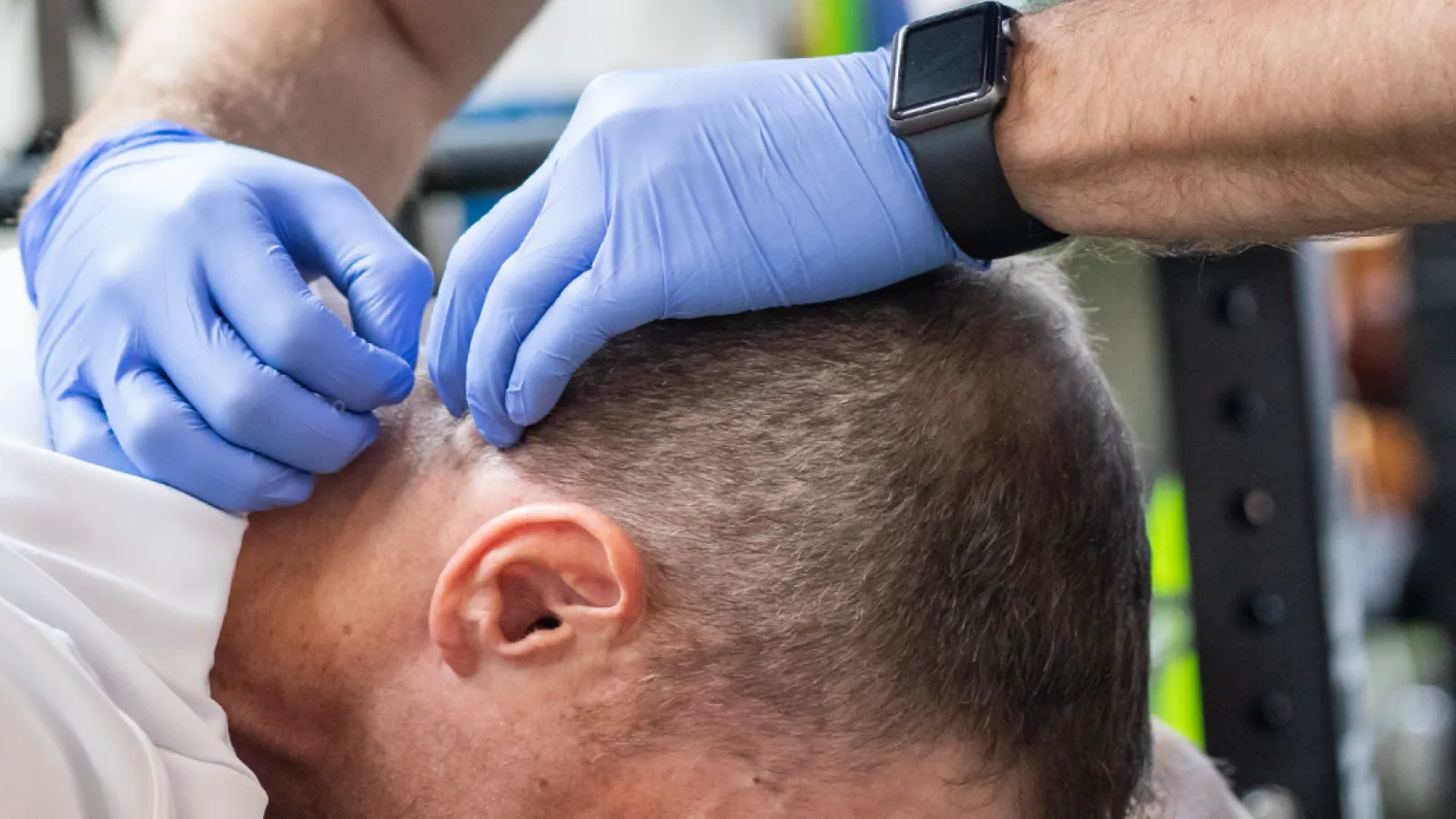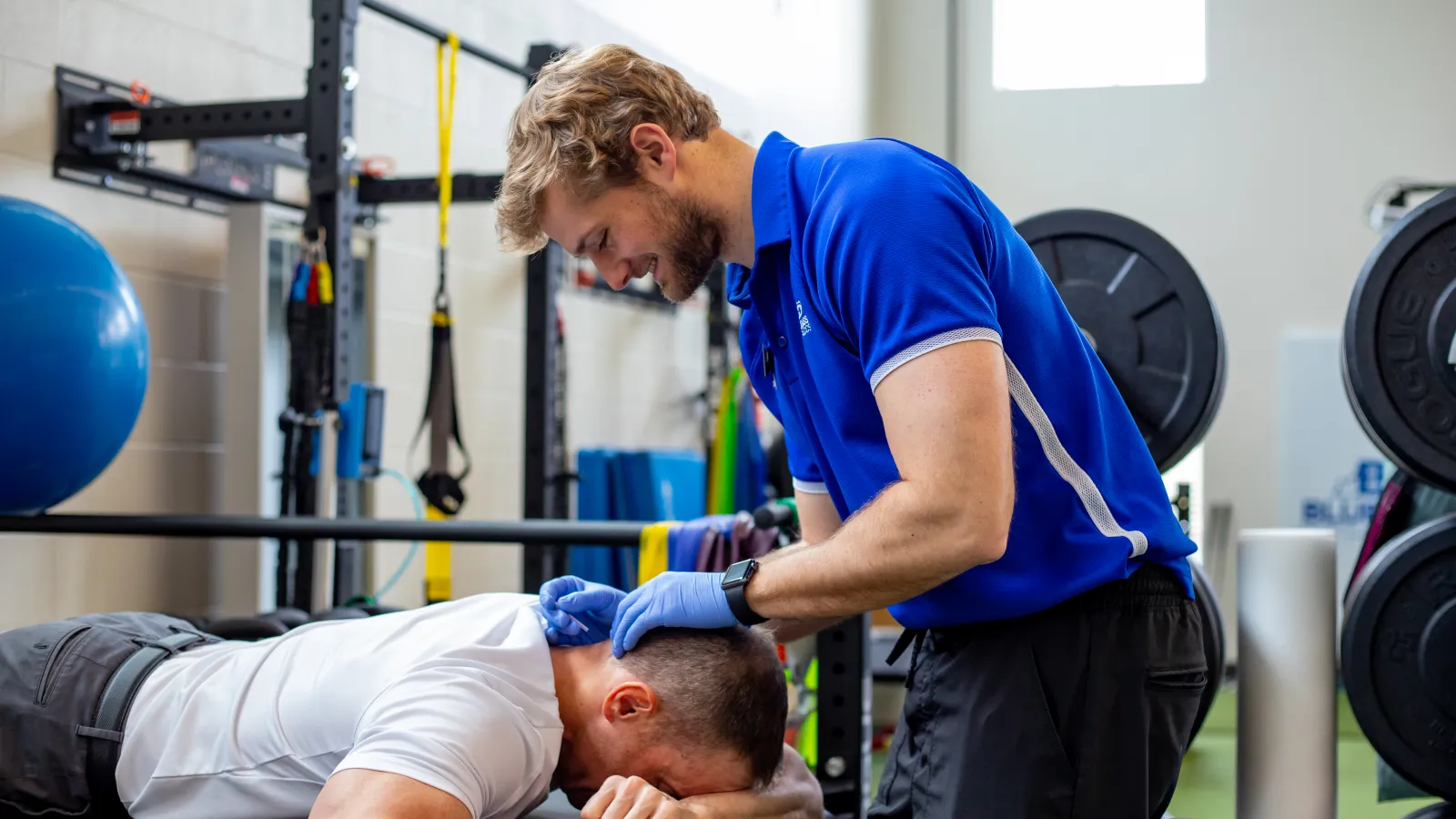
Dry Needling
WHAT IS THE STORY BEHIND "DRY NEEDLING"?
Dry needling (DN) is a treatment strategy commonly employed by many Physical Therapists and other medical professionals whereby solid monofilament needles of varying gauges and lengths are inserted into different soft tissues throughout the body. The purpose of needle insertion and other aspects associated with DN (such as manual manipulation of the needle or the addition of electrical stimulation intra-tissue) is primarily to reduce pain and return the individual to their prior functional level as quickly as possible with minimal discomfort. All the traditional forms of Physical Therapy are still utilized to help the client, but DN has been a great addition to help improve the overall efficacy of treatment sessions.
A very fine filament or 'needle' (think~ an extremely thin guitar string [usually no more than the diameter or 2-3 strands of human hair]) is inserted through the skin and into the deeper tissues that are considered to be inflamed, or the problem areas determined by your physical therapist.
The theory behind how and why "Dry Needling" works, is by causing a 'microlesion' within the pathological tissue thus breaking up shortened tissues, inhibiting reflex arcs from the nervous system to the tissue, normalizing the inflammatory response, and centrally mediating the pain. This mechanical, bio-chemical and neuromuscular effect provides an environment that enhances the body's ability to heal which ultimately reduces pain.
Dry Needling (DN'ing) is NOT synonymous with the Traditional Chinese Medicine (TCM) style of acupuncture, and a distinction needs to be made.
"ACU" from Latin simply implies a "sharp point", and PUNCTURE, obviously implies "going through something like the skin or other objects". So while the word "acupuncture" often makes one think of TCM, it is not.
The mechanisms of needle insertion, though similar in nature, are differentiated in the application and theory behind the two different types of needling interventions. DN'ing has been developed on a foundation of the general principles of western medical science. The proper practice of DN'ing require that the practitioner has formal medical education, with comprehensive training from the basic sciences, human anatomy (human cadaveric dissection), neuroanatomy, kinesiology, biomechanics, physiology, pathology, & clinical diagnoses etc. all of which gives the Dry Needler a strong three dimensional understanding of the body. Contrasted with Traditional Chinese Medicine which was developed over hundreds of years ago in a culture that did not demand scientific inquiry in the same way as we do now in western medicine.
One is not necessarily bad and the other good, it is just that DN'ing principles are based evidence, & has the backing of the scientific / medical community as an accepted medical procedure. David Escobar has practiced physical therapy for over 31 years, and stay's up to date with the current trends in the profession. David has completed both foundational & advanced "Dry Needling" course work from several different schools of thought with-in the Dry Needling world.
DN'ing is more than "trigger point dry needling" (TrP-DN) or "intra-muscular manual therapy" (IMMT). Though commonly described as, or referred in these two terms, DN'ing is much more than these two narrowly defined titles. DN'ing focuses on nerves, tendon insertions onto bones, ligamentous structures, bursitis pathology, trigger points regions of muscle, strains conditions. The breadth of conditions effectively treated by DN'ing leads to a definition that is much more broad than TrP-DN or IMMT lends credit to. Dry Needling can be utilized for athletes of all ages as a preventative, maintenance and as a treatment effect.
Dry Needling has been shown to be effective for many forms of arthritis, tendonitis, muscle aches and pain, joint pains such as knee pain, shoulder pain, temporal mandibular joint pain, neck and back pain etc.
Several recent studies have shown that those diagnosed with mild to moderate knee osteoarthritis have very favorable improvements in pain scores, increased function and increased tolerance for strengthening exercise with a form of Dry Needling.
David will be starting a new scientific study to help establish how much of a need (if any) for follow-ups after treatment.
Please contact David @ david.escobar@bluegrassortho.com if you or someone you know might
qualify with mild to moderate knee osteoarthritis that would like to participate in this study.

BGO Dry Needling
Dry Needling
FAQs
What Is Dry Needling?
Dry Needling is an invasive procedure in which a solid filament needle is inserted into the skin and muscle directly at a Myofascial trigger point. Physical therapists at Bluegrass Orthopaedics utilize trigger point dry needling in the treatment of Myofascial pain. A Myofascial trigger point consists of multiple contraction knots, which are related to the production and maintenance of the pain cycle.
How Does Dry Needling Work?
The exact mechanisms of trigger point dry needling are unknown. There are mechanical and biochemical effects. Based on the pioneering studies by Dr. Jay Shah and colleagues at the National Institute of Health, we know that inserting a needle into trigger points can cause favorable biochemical changes, which assist in reducing pain. It is essential to elicit the so-called local twitch responses, which are spinal cord reflexes. Getting local twitch responses with trigger point dry needling is the first step in breaking the pain cycle.
Is Dry Needling Similar to Acupuncture?
There are many similarities and differences between trigger point dry needling and acupuncture. Licensed physical therapists in a growing number of states can use trigger point dry needling under the scope of their practice. Physical therapists at Bluegrass Orthopaedics are not licensed acupuncturists and do not practice acupuncture. In contrast to most schools of acupuncture, trigger point dry needling is strictly based on Western medicine principles and research.
What Type of Problems Can Be Treated With Dry Needling?
Dry needling can be used for a variety of musculoskeletal problems. Muscles are thought to be a primary contributing factor to the symptoms. Such conditions include, but are not limited to neck, back, and shoulder pain, arm pain (tennis elbow, carpal tunnel, golfer's elbow), headache to include migraines and tension-type headaches, jaw pain, buttock pain and leg pain (sciatica, hamstring strains, calf tightness/spasms). The treatment of muscles has the greatest effect on reducing the pain mechanisms in the nervous system.
Is the Dry Needling Procedure Painful?
Most patients do not feel the insertion of the needle. The local twitch response elicits a very brief (less than a second) response. Some patients describe this as a little electric shock; others feel it more like a cramping sensation. Again, the therapeutic response occurs with the elicitation of local twitch responses and that is a good and desirable reaction.
Are the Needles Sterile?
Yes, Bluegrass Orthopaedics only uses sterile needles.
What Side Effects Can I Expect After the Treatment?
Most patients report being sore after the procedure. The soreness is described as muscle soreness over the area treated and into the areas of referred symptoms. Typically, the soreness lasts between a few hours and two days.
What Should I Do After Having the Procedure Done?
Our recommendations vary depending on the amount of soreness you have and on the individual response to the treatment. Recommendations may include applying heat or ice over the area, gentle stretches and modifications of activities.
How Long Does It Take For the Procedure to Work?
Typically, it takes several visits for a positive reaction to take place. We are trying to cause mechanical and biochemical changes without any pharmacological means. Therefore, we are looking for a cumulative response to achieve a certain threshold after which the pain cycle is disturbed.
Where Does Dry Needling Fit Into the Rehabilitation Program?
Generally speaking, trigger point dry needling is the modality of choice when it comes to treating patients in the clinic. More frequently, trigger point dry needling is needed in the beginning in order to break the pain cycle. Once that is achieved, other treatment options are introduced.
Where to Find Dry Needling Therapy?
BGO currently offers Dry Needling at all of it's physical therapy locations:
BGO - Georgetown
BGO - Sports Medicine & Physical Performance Center
BGO - Brannon Crossing Physical Therapy
BGO - Harrodsburg Road
For patients that are interested in Dry Needling outside of a normal physical therapy session, BGO Physical Therapy offers this service to patients as an exclusive treatment for $65 per initial session and $45 per session thereafter.
For more information about Dry Needling at Bluegrass Orthopaedics, call 1-859-263-5140.